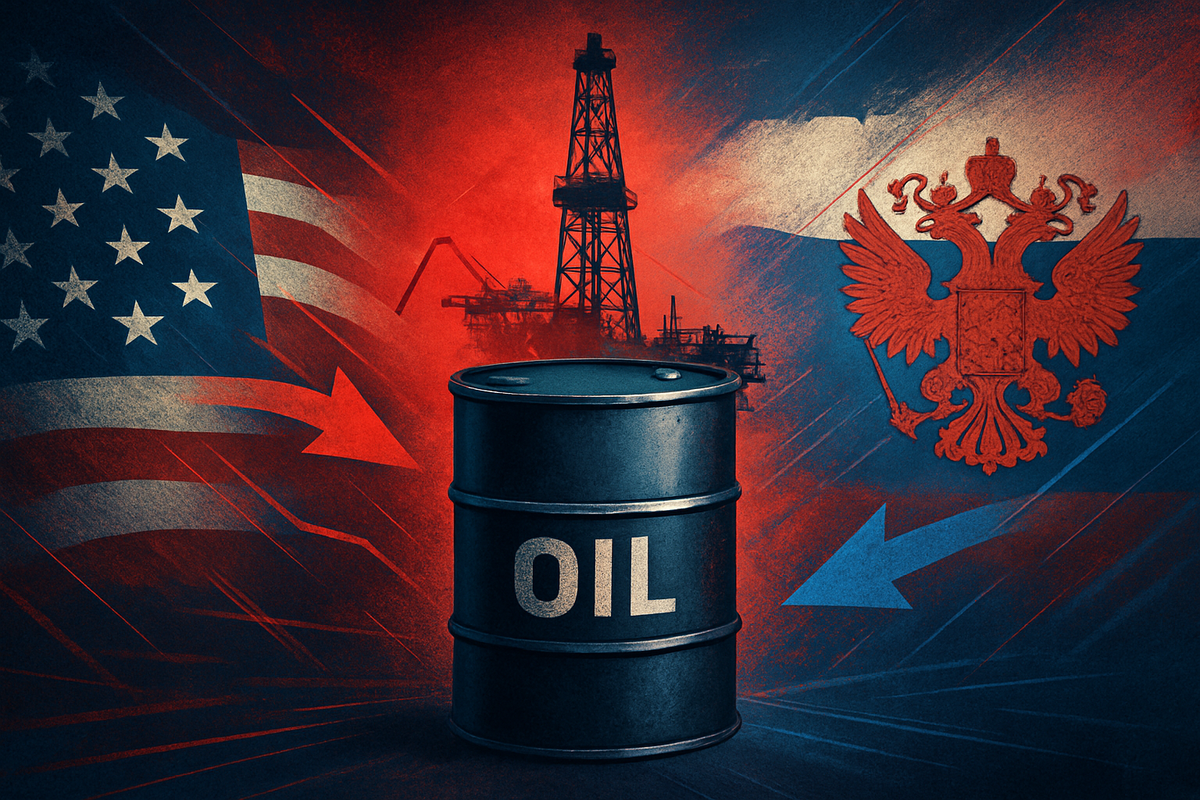
Washington D.C. – October 23, 2025 – In a move described as an "unprecedented escalation," the U.S. Treasury Department on October 22, 2025, imposed sweeping sanctions on Russia's two largest oil companies, Rosneft (MCX: ROSN) and Lukoil (MCX: LKOH). This decisive action, coming swiftly after President Trump's cancellation of a planned meeting with President Putin, aims to exert maximum economic pressure on Moscow to achieve an immediate ceasefire in the ongoing conflict in Ukraine. The sanctions have ignited an immediate surge in global crude oil prices and sent shockwaves through financial markets, forcing a dramatic re-evaluation of energy supply chains worldwide.
The new measures directly target the heart of Russia's revenue generation, freezing all U.S.-based assets of Rosneft and Lukoil and prohibiting American individuals and entities from conducting any transactions with them. Crucially, the sanctions carry the potent threat of secondary sanctions against any foreign financial institutions or companies that continue to engage in significant transactions with the blacklisted entities. This aggressive stance, implemented just yesterday, signals a pivotal moment in the West's economic campaign, designed to severely curtail Russia's ability to fund its military operations and fundamentally alter the global flow of its vast energy resources.
Sanctions Rock Energy Markets as Washington Intensifies Pressure
The U.S. Treasury's announcement yesterday delivered a direct blow to Russia's energy sector, specifically targeting Rosneft (MCX: ROSN) and Lukoil (MCX: LKOH). These sanctions are designed to sever the companies' access to the international financial system, making it exceedingly difficult for them to conduct transactions, access credit, and ultimately sell their vast oil reserves on the global market. The measures were put in place following President Trump's decision to scrap a scheduled meeting with President Putin, citing a lack of tangible progress in peace negotiations surrounding the conflict in Ukraine. This cancellation underscored Washington's growing impatience and resolve to employ more stringent economic tools.
The immediate market reaction was swift and pronounced. Global crude oil prices surged, with Brent crude climbing by 4.7% to 5.7%, settling in the range of $65.50 to $66.13 per barrel. Similarly, U.S. West Texas Intermediate (WTI) crude experienced a rise of approximately 4.9% to 5.6%, reaching $61.39 to $61.77 per barrel. This sharp increase was fueled by concerns that the removal of such significant players from the global supply chain would create an immediate deficit, even as Russia seeks alternative buyers. The sanctions also carry the potent threat of secondary sanctions, which could be levied against any foreign financial institutions that continue to engage in transactions with the now-blacklisted Russian entities. This threat has already prompted major purchasers of Russian oil, particularly in key Asian markets, to reconsider their import strategies. Chinese state oil majors have reportedly suspended purchases of seaborne Russian oil, while Indian refiners are expected to sharply curtail or even halt their imports, fearing exclusion from the vital U.S. financial system.
The ripple effects extended to financial markets globally. In Moscow, the stock exchange reacted with a sharp decline, reflecting the immediate economic uncertainty. The MOEX Russia Index, a benchmark for Russian equities, fell by as much as 3.6%, with the RTS Index, tracking dollar-denominated Russian stocks, experiencing a similar downturn. Shares of the directly sanctioned companies bore the brunt of the sell-off, with Rosneft's stock dropping by 3.78% and Lukoil's by 5.85%. Conversely, major Western energy companies, such as Shell (LSE: SHEL) and BP (LSE: BP.), saw their share prices climb by approximately 3%, contributing to the FTSE 100 reaching a new record high. This divergence highlights a potential shift in market advantage, favoring non-Russian producers and refiners who stand to benefit from higher global oil prices and reduced competition. The sanctions are expected to reshape global energy flows and trade dynamics, potentially leading to new pricing structures and long-term supply routes as Russia is forced to deepen ties with non-Western buyers, particularly in Asia. While the immediate impact on Russian oil revenues might be partially offset by the rising global oil prices, the sanctions unequivocally signal Washington's intent to severely squeeze Russia's financial lifeline.
Shifting Fortunes: Who Wins and Who Loses in the Sanctions Aftermath
The U.S. Treasury's stringent sanctions against Rosneft (MCX: ROSN) and Lukoil (MCX: LKOH) have immediately reshaped the competitive landscape of the global energy market, creating clear winners and losers across various sectors. The primary targets, Rosneft and Lukoil, are undeniably the biggest losers. With their U.S.-based assets frozen and effectively cut off from the dollar-based financial system, their ability to conduct international transactions, secure financing, and sell their substantial crude and refined products globally will be severely hampered. These two companies, which collectively account for nearly half of Russia's crude oil exports, are facing a drastic reduction in market share, forcing them to find new, often less lucrative, avenues for sales. Their profitability will inevitably suffer from reduced volumes, the necessity of offering steeper discounts, and increased operational complexities in navigating non-Western supply chains. The immediate 3.78% and 5.85% drops in their respective share prices on the Moscow Stock Exchange underscore the gravity of their predicament.
The ripple effect extends significantly to international refiners, particularly those in India and China, who have become major consumers of discounted Russian crude since 2022. Companies such as Reliance Industries (NSE: RELIANCE), India's largest private refiner, are now compelled to scale back or even halt imports from Russia, including those under long-term deals. This necessitates a search for alternative crude suppliers, likely at higher prices, which will compress refining margins and impact profitability. Other prominent Indian state-owned refiners like Indian Oil (NSE: IOC), Bharat Petroleum (NSE: BPCL), and Hindustan Petroleum (NSE: HINDPETRO) are also assessing compliance risks and curtailing direct imports. In China, major state oil players including PetroChina (HKG: 0857), Sinopec (HKG: 0386), and CNOOC (HKG: 0883) have reportedly suspended purchases of Russian seaborne oil, facing similar pressures and increased procurement costs. The threat of secondary sanctions also casts a long shadow over financial institutions facilitating these transactions, forcing them to de-risk and potentially isolate Russian energy financing from traditional global banking systems. Shipping companies involved in the transport of Russian oil, especially those operating in the so-called "shadow fleet," will face heightened scrutiny, increased operational costs, and significant risks, including the potential for vessel seizures or further sanctions.
Conversely, the sanctions have created a boon for international oil producers outside of Russia and major Western integrated energy companies. With a significant portion of Russian crude potentially sidelined, non-Russian producers are poised to see increased demand for their output, leading to an expansion of their market share and boosted profitability driven by higher global oil prices. OPEC+ has already signaled its readiness to "recalibrate supply," hinting at potential output increases to stabilize the market. Major Western oil companies such as Shell (LSE: SHEL) and BP (LSE: BP.), ExxonMobil (NYSE: XOM), and TotalEnergies (NYSE: TTE) are already benefiting from the surge in crude prices. Shell and BP, for instance, saw their shares jump approximately 3% following the announcement, contributing to a record high for the FTSE 100. U.S. refiners like Valero (NYSE: VLO) are also experiencing expanded refining margins due to stronger crack spreads. Shipping companies not involved in Russian oil trade or those positioned to serve new, redirected global trade routes may also capitalize on increased freight rates and demand as global energy flows adjust to the new geopolitical realities. The sanctions, therefore, are not merely a punitive measure but a catalyst for a profound redistribution of market power and profitability within the global energy complex.
A New Era of Energy Geopolitics: Wider Significance and Global Repercussions
The U.S. Treasury's direct targeting of Rosneft (MCX: ROSN) and Lukoil (MCX: LKOH) represents a profound shift in the broader landscape of energy geopolitics and a significant escalation in the economic confrontation with Russia. This move, executed on October 22, 2025, aligns with a broader industry trend of Western nations systematically dismantling Russia's capacity to fund its military objectives through energy exports. Coming concurrently with the European Union's 19th sanctions package, which includes a ban on Russian liquefied natural gas (LNG) imports, these coordinated actions signal an unwavering commitment to drain Moscow's vital oil and gas revenues, which historically constitute a substantial portion of its state budget. Energy analysts are increasingly vocal, describing these sanctions as an "unprecedented escalation" that could flip the global oil market into a deficit if effectively enforced, fundamentally altering supply-demand dynamics.
The ripple effects of these sanctions are already being felt globally, particularly in major Asian economies that have become significant buyers of discounted Russian crude. India and China, which collectively import millions of barrels of Russian oil daily, are now compelled to sharply curtail or halt their purchases from the sanctioned entities. Chinese state oil majors, including PetroChina (HKG: 0857), Sinopec (HKG: 0386), CNOOC (HKG: 0883), and Zhenhua Oil, have reportedly suspended purchases of Russian seaborne oil, fearing the punitive reach of secondary sanctions. Similarly, major Indian refiners like Reliance Industries (NSE: RELIANCE) are reviewing their import strategies to ensure compliance. This forced diversification will inevitably lead to increased competition for non-Russian crude, potentially driving up prices in other markets and reorganizing global oil trade routes. While Russian President Vladimir Putin has downplayed the long-term impact, experts suggest these measures will further weaken Russia's economy and its ability to finance its military operations, forcing it to seek deeper discounts or divert products through non-sanctioned channels. Conversely, other oil producers and Western energy giants like Shell (LSE: SHEL) and BP (LSE: BP.) stand to benefit from the reduced Russian supply and subsequent higher global oil prices.
From a regulatory and policy standpoint, these sanctions underscore a hardening stance by the U.S. administration, reflecting growing frustration with Russia's continued aggression. The freezing of all U.S.-based assets of Rosneft and Lukoil, coupled with the prohibition of transactions by American individuals and entities, is a direct and powerful measure. The U.S. Treasury has provided a wind-down period until November 21, 2025, for companies to cease transactions, emphasizing the immediate nature of compliance. Crucially, the threat of secondary sanctions on foreign financial institutions marks a significant policy instrument designed to extend U.S. jurisdiction globally, making it exceedingly difficult for Rosneft and Lukoil to operate in U.S. dollars or access Western banking systems. This coordinated international approach, also evident in the EU's concurrent sanctions and efforts to prevent circumvention, signals a united front against Russia's economic lifelines.
Historically, the U.S. has imposed sanctions on Russia's energy sector since 2014, following the annexation of Crimea. However, those earlier measures primarily aimed at limiting future production capacity and debt access, rather than direct blocking sanctions on the largest producers. The current actions bear a closer resemblance to the aggressive use of secondary sanctions against Iran, where extraterritorial measures effectively isolated its energy and financial sectors from the global economy. These latest sanctions are not an isolated event but a continuation of an escalating pressure campaign that has progressively targeted Russia's economic vulnerabilities since the full-scale invasion of Ukraine in 2022, building upon previous efforts like the G7's oil price cap implemented in December 2022. This marks a new chapter in economic warfare, with profound implications for global energy security and international relations.
The Road Ahead: Navigating a Fractured Global Energy Landscape
The U.S. sanctions imposed on Rosneft (MCX: ROSN) and Lukoil (MCX: LKOH) on October 22, 2025, have ushered in an era of profound uncertainty and potential transformation for global energy markets. In the short term, the immediate aftermath has been characterized by acute price volatility and supply chain disruptions. Brent crude futures, for instance, surged by 5.5-5.7% to the $66-$67 per barrel range, with WTI futures experiencing a similar leap to $61-$62 per barrel. This reflects market anxiety over the potential curtailment of 2.2 to 3.1 million barrels per day of Russian oil exports. Major buyers in India and China, including Reliance Industries (NSE: RELIANCE), PetroChina (HKG: 0857), and Sinopec (HKG: 0386), have already begun suspending or sharply reducing purchases from these sanctioned entities, fearing the reach of secondary sanctions. This hesitation will likely force Russia to offer deeper discounts and incur higher logistical costs, further eroding its oil revenues.
Looking further ahead, the long-term possibilities suggest a sustained period of pressure on Russia's energy sector. The sanctions are designed to degrade the Kremlin's ability to fund its war, potentially leading to a prolonged financial squeeze and a reconfiguration of global oil trade routes. While Russia has previously adapted by rerouting exports to Asia, the direct targeting of its largest companies and the threat of secondary sanctions on key Asian buyers could necessitate a more profound and costly shift in its energy export strategy, potentially involving a greater reliance on its "shadow fleet" and alternative financial mechanisms. This ongoing geopolitical risk could also accelerate global investments in non-Russian oil and gas production, as nations prioritize energy security and diversify their supply sources, potentially leading to structural shifts in the overall energy supply landscape.
Various stakeholders are now forced into strategic pivots. For Rosneft and Lukoil, adaptations will likely include an expanded use of aging tankers, opaque trading practices, and potentially deeper discounts to a more limited pool of buyers. They may also intensify efforts towards technological self-sufficiency in their energy sector. Major buyers like India and China will prioritize diversifying their crude sources and mitigating risks in financial transactions, potentially seeking bilateral negotiations with the U.S. to clarify sanction parameters. On the supply side, OPEC+ has indicated a readiness to offset market shortages, with Kuwait's Oil Minister stating the cartel could increase output to stabilize prices. This response will be crucial in determining the ultimate impact on global supply.
The market opportunities arising from these sanctions include new supply contracts for non-Russian producers and a potential acceleration of investments in renewable energy and energy efficiency as countries seek greater independence from volatile fossil fuel markets. However, significant challenges loom, including heightened price volatility, the risk of sustained supply shortages and inflated prices that could dampen global economic growth, and the ongoing geopolitical instability. Potential scenarios for global crude oil prices in the short term (next 3-6 months) range from a baseline of moderate increases and volatility (Brent $65-$75) to a significant spike above $75-$80 if Russian exports are severely curtailed and not quickly offset. In the long term, a sustained period of higher prices and a permanent bifurcation of global oil markets, coupled with an accelerated energy transition and a structurally weakened Russian energy sector, appear to be distinct possibilities. The coming months, particularly leading up to the November 21, 2025, wind-down deadline, will be critical in shaping these outcomes.
Conclusion: A New Chapter in Global Energy Dynamics
The recent U.S. sanctions on Rosneft (MCX: ROSN) and Lukoil (MCX: LKOH) represent a profound and arguably unprecedented escalation in the economic pressure campaign against Russia. The key takeaway is a clear intent from Washington to directly cripple Russia's primary financial lifeline, even at the risk of global market volatility. While Russia's leadership acknowledges "certain consequences," the effectiveness of these sanctions hinges critically on the rigorous enforcement of secondary sanctions, particularly targeting financial institutions and major buyers in countries like India and China.
Moving forward, the global oil market faces a complex interplay of forces. Even prior to these sanctions, an underlying sentiment of oversupply persisted, with global inventories near four-year highs. Russia's oil revenues were already in a "sustained downward spiral" throughout 2025 due to lower global prices and reduced refined product exports. These new sanctions, therefore, land on an already strained Russian energy sector, aiming to exacerbate its challenges. Russia is expected to intensify its efforts to circumvent restrictions through its "shadow fleet" and deeper ties with non-Western partners, but the formidable threat of being cut off from the powerful U.S. banking system for dollar transactions presents a significant deterrent.
The lasting impact of these sanctions will likely be a permanent reshaping of global energy flows, with Russia's exports increasingly redirected towards Asia, often at deeper discounts. While some analysts remain skeptical that the sanctions will drastically reduce Russia's overall export volumes in the long term, they are widely expected to increase Russia's costs of doing business and significantly reduce its revenue generation. This marks a "massive U-turn" in strategy, going further than previous administrations by directly targeting the largest producers, signaling a new era of economic warfare.
Investors in the oil market must remain highly vigilant in the coming months. Key factors to watch include:
- Enforcement of Secondary Sanctions: The U.S. Treasury's efficacy in enforcing secondary sanctions on foreign entities, especially banks and traders in China and India, will be paramount.
- Responses from Key Buyers (India and China): Observe whether India and China's initial reported suspensions of Russian oil purchases become sustained reductions, or if they find new, opaque mechanisms to continue buying.
- Global Supply/Demand Balance: Despite the sanctions, the prevailing global oil surplus continues to exert downward pressure on prices. Investors should watch for any shifts in global demand growth (particularly from China) and non-OPEC+ supply, which could either amplify or mitigate the impact of Russian supply disruptions.
- Russian Workarounds and "Shadow Fleet" Expansion: The speed and sophistication with which Russia adapts its logistics, shipping, insurance, and payment systems to circumvent sanctions will be a key factor in how much oil reaches the market and at what price.
- Geopolitical Developments: Any further escalation or de-escalation in the Ukraine conflict, or additional retaliatory measures from Russia, could introduce new volatility into the market.
- Oil Price Movements: While a short-term price jump occurred, the long-term trajectory will depend on the interplay of the above factors. Some analyses suggest Brent crude could average around $64/b in 2025 and $60/b in 2026, indicating continued subdued prices unless significant supply disruptions occur.
In conclusion, while the latest U.S. sanctions represent a potent symbolic and actual escalation against Russia's energy sector, their ultimate impact on global oil markets and Russia's revenues will be a complex interplay of enforcement, adaptation, and prevailing global supply-demand dynamics. The market is entering a period of heightened uncertainty, demanding careful navigation from all stakeholders.
This content is intended for informational purposes only and is not financial advice


















